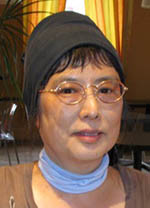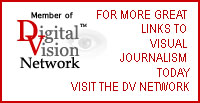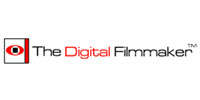|
|
If you're a traveler at heart and you love seeing the world, then you must experience Visa Pour L'Image at least once in your lifetime. And if you're a professional journalist who draws inspiration from the works of your most talented colleagues, then you must roam this annual photo festival at least once during your career. Visa Pour L'Image photo festival happens every summer in the quaint French city of Perpignan, France, which is on the train route from Italy to Barcelona, Spain. If you love visual travel, it is the Grand Central Station of visual safaris. At nine venues and exhibitions, you can see photo essays and video shorts transporting you to dark corners and sunny spots across the globe. 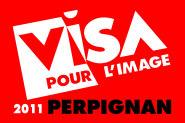 I like to say that photojournalism opens your eyes before you realize they're closed. It shows you the details, subtleties and obscurities that you never thought about. For example, you probably knew that Somalia is a lawless and impoverished country. But Ed Ou's photo essay, "Children of Men," shows you the hardscrabble, daily life of boys forcibly conscripted into militia and squatting in abandoned, partially ruined buildings leftover from the Italian colonial era. A text provides background: Somalia's 20-year civil war has sprouted militia that pluck 10-, 11- and 12-year-old boys off soccer fields, shove loaded guns into their skinny arms and force them to fight. Ou shows us a boy toting a gun too big for his bony shoulders; a 12-year-old, who should be shooting hoops, instead cleaning his kalishnikov; and a boy, probably dreaming of hometown adventures, sleeping alongside his rifle. 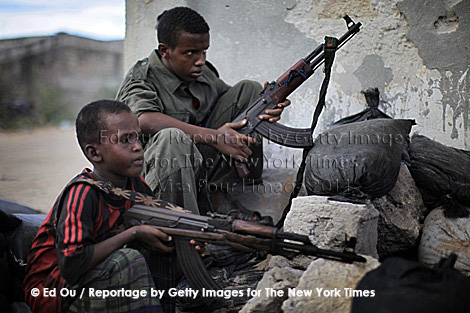 Photograph by Ed Ou - Courtesey Visa Pour L'image And why should we open our eyes to the warping of Somali children? Because American taxpayers fund it. The U.S. government aids Somalia's Transitional Federal government, which resorts to kidnapping as its army recruitment policy--despite claims to the contrary. "Children of Men" is one of many photo essays hanging in old French buildings unequipped with air conditioning, so I periodically go to the air conditioned Palais des Congrés, hub for professional photojournalists and corporate sponsors during the festival's first week. If you're a credentialed professional, you enjoy full access to the Palais, which includes a second-floor auditorium filled with corporate booths. In addition, you can attend restricted events and hob nob with industry superstars. Among the notables in attendance: Christopher Morris, Anthony Suau, Jerome Delay, Yuri Kozyrev, Riccardo Venturri, Jonas Bendiksen and Todashi Okubo. If you're not a credentialed professional wearing a name badge around your neck, then you can hangout in the lobby and occassionally chat with a multi-lingual receptionist during his/her downtime. You can also use the restrooms in the basement. I wanted to attend a roundtable discussion on the current relationship between agencies and photojournalists, but it was restricted to professionals only. I asked an organizer's assistant, "Could non-credentialed people fill empty seats at the beginning of the program?" The woman chuckled sweetly as if she found my proposal amusingly absurd, and then she said, "No." I also wanted to attend Brian Storm's Mediastorm event, but it was "By Invitation Only," so I didn't even bother to ask for access. Later, I learn from an especially helpful receptionist that I may attend all events in Salle Trenet, an auditorium off the lobby area. I do not see this notation on the agenda, which is entirely in French. But I do attend one round table discussion that is meandering and uninformative because of an overly gabby moderator. I establish a pattern of viewing two or three exhibits, then returning to the Palais des Congrés to soak up air conditioning. On Friday, September 2, I hangout in the lobby for several hours because I want to pounce on a recognizable professional and do an on-the-spot interview. Eventually, Christopher Morris emerges from Brian Storm's "Mediastorm" event, so I run up to him and ask for a picture. In my past encounters with him, Chris has been impeccably polite. He kindly obliges, so I whip out my point-and-shoot, and he puts on his sunglasses. Chris looks Rolling Stones-ish as he stands still in his all-black clothing and rock-star sunglasses. I ask him about the news of the day: Why did Jim Nachtwey leave VII? "Jim does not need an agency," Chris replies, "(because) Jim is Jim. He's as big a photographer as (W. Eugene) Smith." Ok, I say. But to myself, I think: Gene Smith seemed like a basket-case of neediness during the brief time I knew him. In my humble opinion, Gene needed not only an agent, but also a manager, publicist, accountant, researcher, archivist, psychotherapist and several turbo-charged collegues for brainstorming ideas and storylines. Really, it takes a village to properly support a photographer. Although Chris wants to depart with his gaggle of friends, I ask another question. I can be a pain. Susie Linfield's book of art criticism, Cruel Radiance, contains a chapter on Nachtwey. In only that chapter, blank rectangles substitute for photographs. Inside each rectangle are the words: "James Nachtwey Studio refused to give permission for publication of this photograph." A caption succinctly describes the picture. I ask Chris, Why would Jim deny permission? "Jim demands and requires perfection," Chris explains. "Jim is very loyal to his subjects. He doesn't want his work shown in a way that doesn't live up to his requirements. If he didn't allow use of his pictures, then they (Susie Linfield and Jim Nachtwey) couldn't work out an agreement." So then I ask, Doesn't Jim's refusal reflect badly on VII? "No," Chris replies, "not at all." Well, I beg to differ. I have been trying to publish a book on photojournalists for years. A New York agent warned me that my insistence on including many photographs will hamper me because publishers think securing photo permissions is a monster headache. Although I'm stumped by photojournalists not wanting their work disseminated, I'm impressed by those exhibiting at Visa Pour L'Image. Some of these photojournalists obviously spent months, if not years, assembing very engaging visual narratives. I especially like Jonas Bendiksen's "Bangladesh: On The Frontline of Climate Change." Bendiksen provides an upbeat view of Bangladesh, one of the poorest countries in the world with a population of 160 million crammed into a surface area one-quarter the size of France. 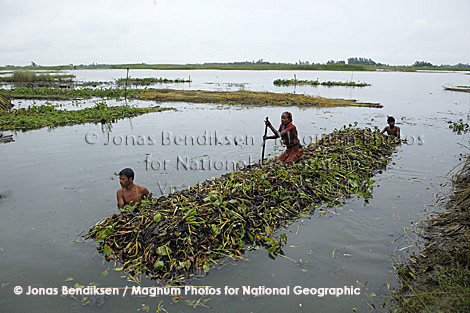 Photograph by Jonas Bendiksen - Courtesey Visa Pour L'image Bendiksen shows us ordinary family life--a beautiful scene resembling a nativity. Women in brightly colored saris cook dinner on a wood-burning stove while men stand around, some holding children. There is one odd element--everybody is in several inches of water. In Bangladesh, monsoons flood the country from May to November, often displacing families. Although Bangladesh has overcrowded cities, inadequate infrastructure and few natural resources, it copes well with inclement weather. When saltwater flooded his rice fields, a farmer dispensed with rice growing and took on crab fattening. Bendiksen shows the farmer standing in water and holding up a crab, swathed in a yellow ribbon, possibly a tape measure. At another gallery, British photographer Peter Dench stands beside his photo essay "England Uncensored" and speaks so irreverantly he's almost a stand-up comedian. Dench describes himself as a working class lad who deeply resents the British class system. He says he can't understand why his countrymen haven't taken up arms, screamed "Revolution!" and decapitated the Queen.  Photograph by Peter Dench - Courtesey Visa Pour L'image Dench points to his photograph of a standing couple kissing in the foreground and a seated man vomiting in the background. "The kiss was rather short," Dench recalls. "I think a proper kiss should last several minutes." When the unpuckered gentleman walked away from his female companion, he dryly told Dench, "That picture better not be published." Dench added, "The picture has been published in more than 80 countries." A day or two later, I go to a small theater inside a gallery and watch a steady stream of Mediastorm videos. There is no talk by Brian Storm and no announcement introducing each video. But all the videos hold viewers' attention, some eliciting audience applause. For me, one of the most memorable videos follows an African man who takes his family's savings, journeys by rickety vehicles and sinkable boats to prosperous France, where he works as a laborer and barely earns enough money to pay his bills and send money home. He almost regrets his life-changing accomplishment, because he ends up with less of a personal life than he had in Africa. Welcome to the industrialized world. As professional week draws to a close, I reflect on how much I enjoyed the festival. For me, daily excursions to exhibits were like relaxing afternoons with the Sunday newspaper. But I wish I had come with friends, with whom I could discuss meaning, impact and politics. Because professionals come to mingle with colleagues, I did not meet a fellow traveler, eager to wander the world via photo exhibits. When I walk pass Jonas Bendiksen's book signing, I see Christopher Morris, who has wrapped his black shirt around his head and is prancing around in a white t-shirt. Always with a posse of friends, Chris appears to be having a gay old time. In addition to dragging along intelligent friends, you should also reserve a hotel room about six months in advance. The rooms go quickly. If you arrive roomless in Perpignan by train, as I did, you'll see several hotels as you exit the station onto Avenue du General de Gaulle. I recommend Hotel Balladins, which has wifi, air conditioning and in-house breakfast, something the other hotels lack. Due to scarce vacancies, I had to change hotels twice. Not fun. But I could walk to exhibits and pass by two grocery stores selling prepared foods at a much lower price than restaurants. And lastly, wear comfortable shoes, because you'll walk endlessly. I bought expensive MBT shoes (it stands for Masai Barefoot Technology) and my feet ached every night. But splurging on shoes and hotel accommodations is nothing compared to the air fare you'll save by visiting Visa Pour L'Image, The festival is bargain travel. It's a plane ticket, a visual safari, a backstage pass to human dramas and momentous events. Don't count the pennies; just go see the world. blog comments powered by Disqus
|

